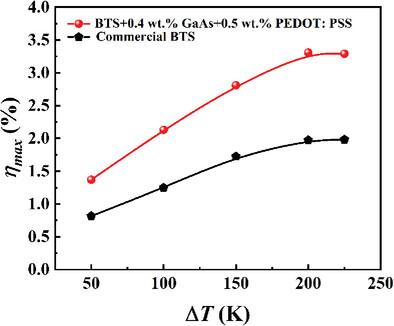Achieving Ultralow Lattice Thermal Conductivity and High Thermoelectric Performance in Bi2Te2.7Se0.3 Alloys via Introducing Organic & Inorganic Nanoparticles
IF 13
2区 材料科学
Q1 CHEMISTRY, MULTIDISCIPLINARY
引用次数: 0
Abstract
N-type Bi2Te2.7Se0.3(BTS) is a state-of-the-art thermoelectric material owing to its excellent thermoelectric properties near room temperatures for commercial applications. However, its performance is restricted by its comparatively low figure of merit ZT. Here, it is shown that a 14% increase in power factor (PF) (at 300 K) can be reached through incorporation of inorganic GaAs nanoparticles due to enhanced thermopower originating from the energy-dependent carrier scattering. Besides, further incorporation of organic nanophase PEDOT: PSS can reduce its lattice thermal conductivity by 59% due to the strong scattering of middle- and low-frequency phonons. As a result, a peak ZT value of ZTmax ≈ 1.31 (at 373 K) and an average ZTave ≈ 1.10 (300–473 K) are achieved for the BTS/(0.4 wt.% GaAs + 0.5 wt.% PEDOT: PSS) sample. The present work demonstrates that incorporation of organic–inorganic nanophase is an effective way to improve the performance of BTS.

求助全文
约1分钟内获得全文
求助全文
来源期刊

Small
工程技术-材料科学:综合
CiteScore
17.70
自引率
3.80%
发文量
1830
审稿时长
2.1 months
期刊介绍:
Small serves as an exceptional platform for both experimental and theoretical studies in fundamental and applied interdisciplinary research at the nano- and microscale. The journal offers a compelling mix of peer-reviewed Research Articles, Reviews, Perspectives, and Comments.
With a remarkable 2022 Journal Impact Factor of 13.3 (Journal Citation Reports from Clarivate Analytics, 2023), Small remains among the top multidisciplinary journals, covering a wide range of topics at the interface of materials science, chemistry, physics, engineering, medicine, and biology.
Small's readership includes biochemists, biologists, biomedical scientists, chemists, engineers, information technologists, materials scientists, physicists, and theoreticians alike.
 求助内容:
求助内容: 应助结果提醒方式:
应助结果提醒方式:


